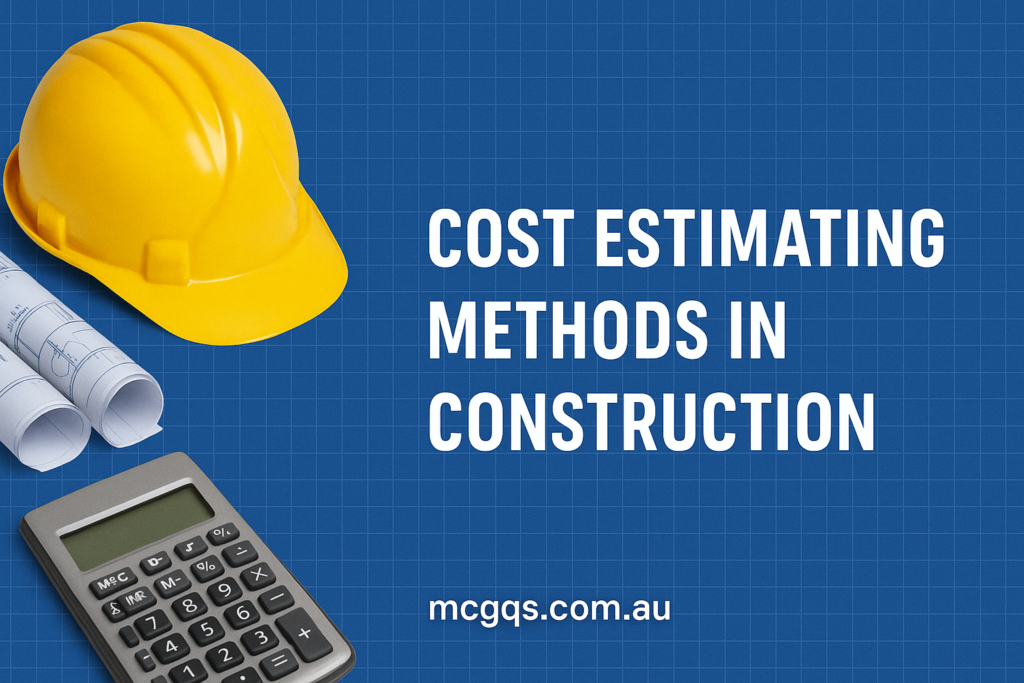Cost Estimating Methods in Construction

In the intricate landscape of construction, financial forecasting is paramount. Ensuring a project stays within budget while meeting all design and functional requirements hinges on accurate cost estimation. Over time, the construction industry has refined and developed several methods to achieve this precision. In this post, we will explore the various cost estimating methods that professionals employ to predict financial expenditures and ensure project success.
1. Square Metre or Unit Cost Estimating
Basics: This method involves calculating the construction cost per square metre (or another unit) based on historical data and then multiplying it by the size of the new project.
Ideal For: Preliminary estimates, especially for projects similar to past endeavors.
Advantages: Quick, relatively straightforward, and can provide a ballpark figure.
Limitations: Might not account for unique project intricacies or fluctuations in labour/material costs.
2. Parametric Estimating
Basics: Uses statistical modeling and historical data to predict costs based on specific parameters or project features.
Ideal For: Projects where past data can be correlated to key parameters (e.g., cost per floor for multi-story buildings).
Advantages: Offers more accuracy than square metre estimating by accounting for specific project characteristics.
Limitations: Requires accurate historical data and understanding of the relationship between parameters and costs.
3. Assemblies / Elemental Estimating
Basics: Involves estimating costs based on assemblies (groups of work items) rather than individual tasks or materials. For instance, instead of estimating concrete, reinforcement, and labour separately, an entire wall assembly is priced.
Ideal For: Detailed preliminary estimates before final designs are available.
Advantages: Offers a more detailed breakdown than unit cost estimating but is faster than line-item estimates.
Limitations: Still requires comprehensive unit cost databases and can be less detailed than other methods.
4. Detailed or Line-Item Estimating
Basics: As the name suggests, this method involves breaking down a project into its smallest components and estimating each item’s cost.
Ideal For: Final estimates before construction begins, when detailed design documents are available.
Advantages: Highly accurate, as it considers every aspect of the project.
Limitations: Time-consuming and requires detailed design documents.
5. Analogous or Top-Down Estimating
Basics: This method relies on the costs of similar, previously completed projects to estimate the new project’s costs.
Ideal For: Early project phases when detailed information is limited.
Advantages: Quick and can be reasonably accurate if past projects are very similar.
Limitations: Relies heavily on historical data and might not account for unique project factors.
6. Three-Point Estimating
Basics: Draws from the PERT (Program Evaluation and Review Technique), where three estimates are made for each activity: most likely, optimistic, and pessimistic. An average is then taken to determine the best estimate.
Ideal For: Projects with a high degree of uncertainty.
Advantages: Accounts for uncertainty and provides a range of potential costs.
Limitations: Requires experienced estimators who can accurately predict best- and worst-case scenarios.
7. Expert Judgment
Basics: Relies on the experience and insights of industry experts to predict project costs.
Ideal For: Unique projects or when other data-driven methods are not applicable.
Advantages: Can tap into specialized knowledge and account for unique project features.
Limitations: Subjective and heavily dependent on the expert’s experience and accuracy.
8. Vendor Bid Analysis
Basics: This method involves obtaining price quotes or bids from vendors and subcontractors.
Ideal For: Final estimates before project initiation and for tasks that will be outsourced.
Advantages: Provides real-world figures directly from potential project participants.
Limitations: Accuracy can vary based on vendor reliability and market conditions.
Conclusion:
Cost estimating in construction is both an art and a science. It requires an intricate blend of historical data analysis, understanding of the current market conditions, and foresight into potential project challenges. The chosen estimating method must align with the project’s phase and available details. Whether you’re using statistical models, expert judgments, or vendor bids, the ultimate goal remains consistent: providing a reliable financial blueprint that paves the way for successful project completion.
By familiarizing yourself with these methods, you’re taking a significant step towards ensuring transparency, accuracy, and efficiency in your construction endeavours. Remember, a well-estimated project lays the foundation for a well-executed build.
